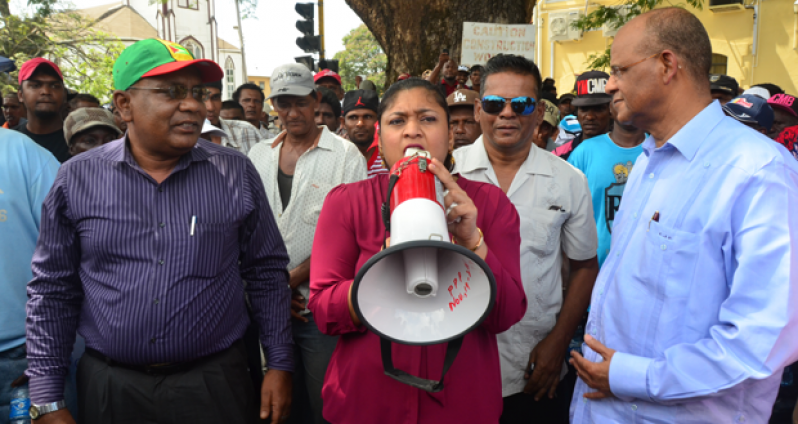Sugar still has a bright future in Guyana
– says $6B allocation crucial to sugar industry’s turnaround
PRESIDENT Donald Ramotar, yesterday, encouraged other sector stakeholders to take an example from Wednesday’s protest by sugar workers outside Public Buildings in Georgetown and defend their rights.
The demonstration was against threats to cut the $6B injection for the sugar industry, an allocation described by Government as critically important to the Guyana Sugar Corporation (GuySuCo).It was the source of some controversy but was unanimously passed in Parliament after a grueling hours-long questioning directed towards Agriculture Minister, Dr. Leslie Ramsammy.
The Head of State declared that the clear message sent by sugar workers to the National Assembly won the day.
He emphasised that the industry is an important one, particularly, considering the thousands who depend on it, both directly and indirectly, employees, their families and the wider communities.
FACING SUGAR
Mr. Ramotar said the disposition of the combined Opposition towards the industry seems to be predicated on a “misunderstanding” of the challenges facing sugar.
“It began with Europe abandoning the protocol where the 36 per cent was cut,” he said, referring to the 2006 arbitrary reduction of price for sugar sold to the European Union (EU).
President Ramotar said it has taken almost one year before the EU accompanying measures came on board with the disbursement of support funds to the ACP sugar producing countries, including Guyana.
The toll, according to major stakeholders in the sector, is that of the price cut on the sugar industry which was significant.
Recently, the EU Commission in Georgetown summarised that, from 2007 to 2011, 91.5M Pounds (Sterling) or G$21.5B have been disbursed to the Guyana Government.
For the years 2012 and 2013, the disbursements are said to be about 45M pounds (Sterling) or about G$10B.
The EU pointed out that only a small portion of the total disbursed had been received by the sugar industry for financing the Enmore Packaging Plant and few budgetary support.
Another major challenge cited by the President is that of climate change.
He acknowledged: “This is a real problem…science has told us that there are real impacts”.
Mr. Ramotar explained that, as a result of climate change, weather patterns have changed and are affecting the industry’s output. For example, in comparison to when they were used to 120 opportunity days, workers now have to make do with 80 or less days.
A comment made by Shadow Finance Minister Carl Greenidge, in Parliament on Wednesday night, dismissing climate change as what he called an “excuse” was also addressed by the President.
Greenidge charged that Guyana has been involved in sugar for hundreds of years now and should be able to anticipate and plan for issues like weather.
SIMPLISTIC PLASTER
However, the President rubbished that simplistic plaster to what is a much more complicated situation.
He stated that such a remark indicates either a clear lack of understanding or ignorance of the matter at hand.
Mr. Ramotar underscored the issue of a diminishing labour pool, given the advances in areas of other opportunities for Guyanese people, hence the need to move to mechanisation, as another challenge that is being addressed.
“These are real problems and we need real solutions,” he said.
The President said no one is denying the challenges facing the industry, nor is anyone disillusioned about what needs to be done, which is why he reiterated that the $6B allocation was quintessential to the industry’s turnaround.
That sum is expected to cover expenditures that include mechanisation, through the conversion of 2,500 hectares of land to be suitable for mechanical operations, which will be done at a cost of $1.1B; tillage and replanting of 9,200 hectares, both efforts being consistent with improving cane production and yield, which will be done at a cost $1B; factory upgrading on all sugar estates, including Skeldon, at a cost of $2B and works to field infrastructure for bettering field to factory access and purchasing of equipment, excavators, bell loaders, tractors, etc., to account for the remainder of the allocation.
BRIGHT FUTURE
“Sugar still has a bright future,” he argued, stating that the industry will return to its glory days of being the leading contributor to the Guyanese economy.
The production in the 2014 first crop is expected to meet its target of 70,000 tonnes of sugar in the next few weeks, he said.
The sugar industry employs about 16,000 people during its peak periods and also facilitates about 1,500 cane farmers. It is also the nation’s largest net foreign exchange earner and a large proportion of its multi-billion-dollar revenue is circulated, thus enhancing many business enterprises.
Many villages and communities surrounding the sugar estates benefit from the industry’s expansive drainage network, too.
Despite its challenges, the industry, according to Government, remains relevant to the health of the national economy.
In 2013, sugar exports accounted for 8.3 percent of the total, valued at US$112.2M and the industry contributed 3.9 percent of the country’s Gross Domestic Product (GDP).
(By Vanessa Narine )



.jpg)








